Essential Kitchen Under Cabinet Light Bulbs Guide
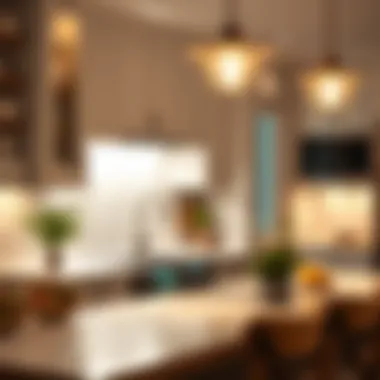
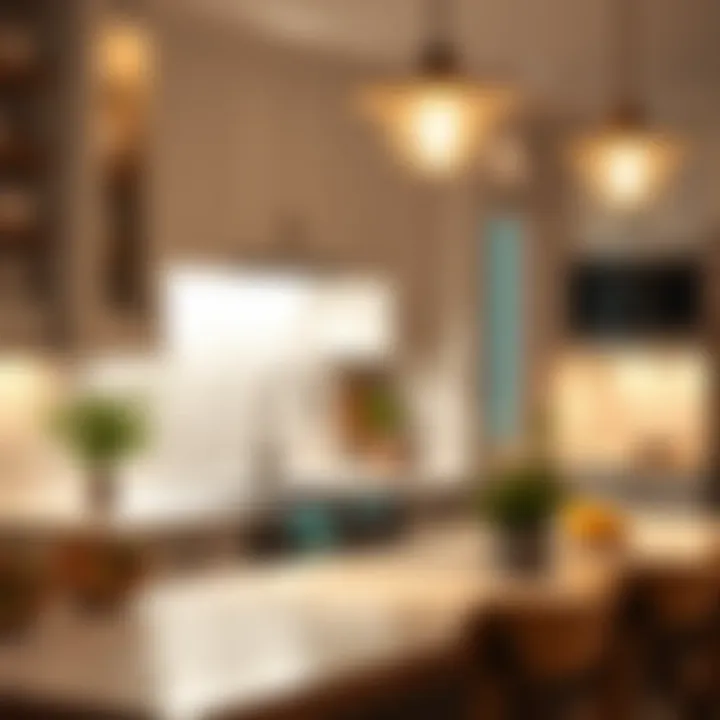
Intro
When stepping into a kitchen, most people often overlook an essential feature: the lighting. More than just a functional aspect, under cabinet light bulbs can dramatically shape the ambiance and usability of this vital space. They illuminate countertops, brighten work areas, and serve as a stylish accent, making their role pivotal in both aesthetics and functionality.
As you're considering renovating or simply upgrading your kitchen setup, it's crucial to explore various lighting solutions available on the market today. Each type of light bulb offers distinct advantages, whether it’s energy efficiency, color temperature, or longevity. This guide aims to dive deep into understanding these different lighting options, their installation nuances, and the benefits they bring to your culinary haven.
Additionally, we'll discuss how proper under cabinet lighting can complement various kitchen designs, from contemporary to rustic. Whether you're a homeowner wanting to enhance your kitchen or a designer looking to bring ideas to clients, grasping the relevance of under cabinet lighting is essential to fulfilling the functional needs and achieving the desired aesthetic impact.
Understanding Under Cabinet Lighting
Under cabinet lighting serves as a vital element within the broader context of kitchen design. This type of lighting not only enhances the functional aspects of the kitchen but also contributes significantly to its aesthetics. By illuminating the space beneath cabinets, it effectively minimizes shadows, making daily tasks easier and more pleasant. Homeowners, designers, and DIY enthusiasts alike recognize the practicality and beauty derived from the correct under cabinet lighting setup.
The importance of understanding under cabinet lighting extends to various factors such as the choice of light types, their placement, and the overall impact on the kitchen's ambiance. Not only does it cater to specific lighting needs, but it also elevates the style of the kitchen, creating a more inviting atmosphere. Thus, this knowledge is essential for anyone looking to improve their kitchen space.
Purpose of Under Cabinet Lighting
The primary objective of under cabinet lighting is to provide direct illumination to work surfaces, allowing homeowners and chefs alike to navigate their culinary tasks with ease. A well-lit countertop ensures safety while cooking, while also reducing the likelihood of accidents caused by poor visibility. Furthermore, it plays a key role in creating mood and ambience, offering options to switch from functional to decorative lighting as needed.
In practical terms, when you chop veggies or read a recipe book, having sufficient light can make all the difference. That's why reliable and adequate under cabinet lighting is not just a luxury; it’s a necessity in a functioning kitchen.
Types of Under Cabinet Lighting
Identifying the types of under cabinet lighting is crucial for making informed decisions. Each type serves different purposes and brings its own unique benefits.
Direct Light
Direct light shines straight down on work surfaces, focusing light exactly where it's needed. Its strong, targeted nature means it’s ideal for tasks like food prep and reading recipes. Many find this to be a popular choice due to its capacity to produce high brightness without excessive glare.
One of the hallmark features of direct light is its ability to enhance color accuracy, which aids in maintaining the true appearance of food and ingredients. However, a notable disadvantage is that it can sometimes create harsh shadows if not placed correctly. Proper installation thus becomes crucial for maximizing its benefits.
Task Light
As its name implies, task light is tailored for specific jobs and routines in the kitchen. Whether it's illuminating a cutting board or focusing on the stovetop while cooking, task lighting provides the right kind of illumination for detailed culinary tasks.
A pivotal characteristic of task lighting is its versatility; it often comes in adjustable formats allowing for flexibility based on personal needs. However, it may not be the best at providing atmosphere or ambient light on its own. Relying solely on this type risks leaving some areas inadequately lit during less task-focused activities.
Ambient Light
Ambient light envelops the entire kitchen area with a soft, diffused glow. This type of lighting sets the overall mood and tone, transforming the kitchen from a purely functional space to a warm and inviting area that encourages conversation and gathering.
One key advantage of using ambient light is that it helps in reducing the jarring effect of contrasting light levels in different parts of the kitchen. It blends seamlessly with other types of lighting, contributing to a cohesive overall design. Yet, it’s essential to connect ambient light with task lighting for an optimal balance, as relying solely on ambient light may fall short in providing the targeted brightness required for specific tasks.
Exploring Different Light Bulb Options
When it comes to under cabinet lighting, the choice of light bulb can make all the difference in creating that ideal kitchen atmosphere. Various bulb types come with their own unique features and benefits that cater to different needs and preferences. Knowing these options is vital not only for aesthetic appeal but also for functionality and efficiency in the kitchen. The next sections will cover the four main light bulb types: incandescent, LED, halogen, and fluorescent.
Incandescent Bulbs
Characteristics
Incandescent bulbs are characterized by their warm glow and relatively simple design. They work by passing an electric current through a thin filament, causing it to emit light. One notable feature of incandescent bulbs is their dimming capability, allowing you to adjust the brightness depending on your mood or activity. While they may not be the most energy-efficient option, they are often preferred for their familiar light quality and color rendering.
Advantages
A key advantage of incandescent bulbs is their excellent color rendering index (CRI), which can make colors in your kitchen appear more vibrant and true to life. This can be particularly important in spaces where food preparation occurs, making ingredients look their best.
Limitations
On the flip side, incandescent bulbs have a relatively short lifespan, usually around 1,000 hours, which translates into frequent replacements. They are also less energy-efficient than modern alternatives, resulting in higher electricity bills over time. Their tendency to generate heat can also be a downside in tightly-spaced kitchens.
LED Bulbs
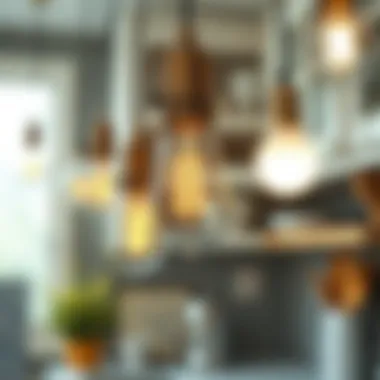
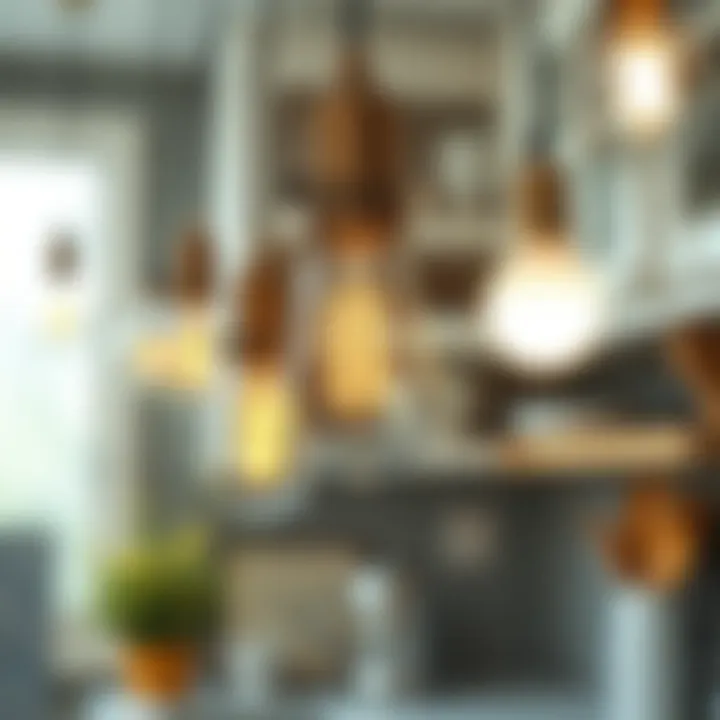
Energy Efficiency
LED bulbs stand out primarily due to their energy efficiency. They consume significantly less wattage than incandescent bulbs, often reducing energy usage by up to 80%. This makes them an environmentally friendly choice, contributing to lower energy costs and reduced carbon footprints.
Lifespan
Another remarkable aspect of LED bulbs is their longevity; they typically last around 15,000 to 25,000 hours, which means you’ll be less likely to climb up on that step ladder for replacements. This durability is a significant advantage for busy households.
Light Quality
When it comes to light quality, modern LED bulbs have improved tremendously, offering a range of color temperatures to suit your preferences. Whether you want a bright, daylight tone for task lighting or a soft, warm hue for ambiance, there's an LED option that fits the bill. Moreover, their consistent illumination without flickering is a plus in busy kitchens.
Halogen Bulbs
Brightness
Halogen bulbs can give off more light per watt than traditional incandescent bulbs. They provide vibrant illumination, making them an excellent option for task lighting under cabinets. Their brightness means you can see the fine details while chopping vegetables or reading recipes.
Color Temperature
Another interesting characteristic of halogen bulbs is their ability to maintain a consistent color temperature, usually around 2700K. This ensures a warm atmosphere in the kitchen, which complements most cabinet designs while enhancing the overall aesthetics.
Heat Generation
While halogen bulbs are synonymous with brightness, they also come with a notable downside: heat generation. They can run very hot, making them less ideal in confined spaces, where they might contribute to a temperature discomfort. Care should be taken to ensure proper ventilation when using halogen lighting.
Fluorescent Bulbs
Design Versatility
Fluorescent bulbs are often thought of as a practical and economically viable choice. They come in various forms, including compact and linear designs, which can fit into diverse kitchen settings. Their slim profile allows for easy installation in tight spots, such as under cabinets.
Energy Consumption
These bulbs consume much less energy compared to incandescent options, and they also have a longer lifespan, averaging around 10,000 hours. This longevity means less hassle for you and more cost savings in the long run.
Environmental Considerations
It's essential to mention that fluorescent bulbs contain small amounts of mercury, which poses environmental concerns upon disposal. Therefore, proper disposal is critical. Additionally, some users may find that they don’t provide a light quality that matches the warmth of incandescent bulbs, making them a less favored choice in certain circumstances.
Factors Influencing Light Bulb Selection
When it comes to choosing the right light bulb for under cabinet lighting, several factors come into play. Each choice impacts the functionality, aesthetics, and energy efficiency of your kitchen space. Understanding these elements allows homeowners, designers, and DIY enthusiasts to make informed decisions tailored to their specific needs. Each consideration highlights how particular characteristics of light bulbs can elevate a kitchen's atmosphere while also meeting practical lighting demands.
Color Temperature Considerations
Color temperature is an essential consideration when selecting light bulbs. It determines how warm or cool the light appears, measured in Kelvins (K).
- Warm White (2700K to 3000K): Provides a cozy and inviting atmosphere, suitable for kitchens intended as gathering spaces.
- Neutral White (3500K to 4100K): Strikes a balance between warm and cool, ideal for general purposes without overwhelming the eye.
- Cool White (5000K to 6500K): Produces a crisp, bright light that mimics daylight, useful for task-oriented spaces where precision is key.
To ensure that your kitchen maintains a consistent look, consider the existing colors and materials. Fixtures, cabinetry, and countertop shades may influence how different color temperatures appear. "Tell me what temperature your light is, and I'll tell you how it feels in the room," rings true here. Finding a cohesive color temperature not only enhances visibility but ensures the space feels thoughtfully designed.
Brightness Levels and Lumens
Brightness is another critical factor, best measured in lumens. When selecting light bulbs for under cabinet lighting, understanding how much light you need can radically affect functionality.
- Task Lighting: Needs higher lumens—around 300 to 700. This ensures adequate illumination for activities such as chopping vegetables or reading recipes.
- Ambient Lighting: May require lower lumens—150 to 300—to provide a softer, more inviting glow that blends with other light sources in space.
Another thing is the lumens per watt ratio, which helps assess overall energy efficiency. A bulb that provides more lumens for fewer watts saves you energy and lowers the electricity bill. This becomes particularly relevant given the rising focus on cost-effectiveness and sustainability in home designs. Remember, too bright can feel stark, while too dim may lead to accidents.
Dimming Capabilities
Dimming capabilities can become the cherry on top of under cabinet lighting. Not all bulbs provide this feature, but those that do bring versatility to the kitchen environment.


- Control Over Atmosphere: Dimming adds an extra layer of ambiance. A brighter setting works well for cooking, while softer, dimmer light during social gatherings can foster a relaxed environment.
- Energy Savings: Being able to reduce brightness not only controls the mood but also conserves energy. Dimming lights can decrease energy usage significantly, contributing to a more cost-effective lighting solution over time.
Before purchasing, ensure your dimmer switch is compatible with your chosen bulb type, as not all bulbs can be dimmed. A strategy that pays off in creating a functional yet adaptable space.
"Good lighting isn't just about bringing light to a room; it's about crafting the mood, dialogue, and energy in the space."
Being thoughtful about color temperature, brightness, and dimming could be the difference between a just-functional kitchen and a beautifully designed space that feels comfortable and vibrant. Choosing wisely is key before making a decision.
Installation Guidelines for Under Cabinet Lighting
When transforming a kitchen, the installation of under cabinet lighting is often an overlooked detail. It's vital to pay attention to this facet, as it contributes significantly to both the functionality and aesthetic appeal of the space. Proper installation can enhance visibility, making meal prep far more manageable, while also beautifying the kitchen’s overall design. Let's delve into the steps and considerations to ensure effective setup.
Choosing the Right Placement
Placement is perhaps the most crucial element in under cabinet lighting. You want those lights to cast a soft, continuous glow without causing disruptive shadows. The most common practice is to position fixtures toward the front of the cabinet. This approach ensures that the light floods the countertop area directly beneath, providing the best illumination for cooking and other tasks.
A few points to consider:
- Cabinet Height: Adjust the height of the fixtures based on your cabinets. For taller cabinets, a slightly lower installation height may be required to achieve optimal lighting.
- Fixture Type: Different types of fixtures can create varying effects. For instance, recessed lights offer a subtle look, while puck lights add character.
- Task Areas: Identify specific areas that need more light. If you have a kitchen island or a small workspace, additional light fixtures might be worth considering.
Wiring Considerations
Wiring can seem intimidating, but tackling this part of your under cabinet lighting project is crucial. The type of wiring you’ll need can depend on both the bulb type and the chosen fixture design. It’s not only about aesthetics; incorrect wiring can lead to flickering lights or worse, a short circuit.
Here are a few guidelines to follow:
- Voltage Requirements: Understand whether you’re working with low voltage or standard line voltage. Generally, LEDs operate on low voltage, requiring a transformer, whereas incandescent bulbs can function on standard voltage.
- Power Source Location: Make sure you know where the nearest outlet is, and plan your wiring accordingly. Discreetly running wires can prevent a cluttered appearance.
- Professional Help: If you are not experienced with electrical work, it may be wiser to call in an electrician. This can save you time and potential safety hazards.
Safety Protocols
Safety should always be at the forefront during installation. Electrical work carries inherent risks, and taking the right precautions is paramount in preventing accidents. Here are a few key safety protocols:
- Turn Off Power: Before you start, make sure to switch off the electrical circuit to avoid any electrical shocks.
- Use Proper Tools: Ensure you are equipped with the right tools such as wire strippers, screwdrivers, and safety goggles to protect your eyes from flying debris.
- Testing Fixtures: After installation, run a test to ensure that everything operates correctly. If you notice any flickering or odd behavior, check connections and wiring.
- Follow Local Codes: Every locale has electrical codes and regulations. Make sure your installation follows these to ensure compliance and safety.
Aesthetic Considerations in Design
When it comes to the hustle and bustle of kitchen activities, lighting can make or break the overall visual experience. Aesthetic considerations in designing under cabinet lighting not only affect the functionality but also the style of your kitchen. Choosing the right lighting fixtures contributes significantly to creating an atmosphere that is both inviting and practical. This duality is essential for homeowners and designers aiming for that perfect balance—it’s about more than just illuminating space; it’s about transforming the kitchen into a delightful realm for cooking and congregating.
Choosing Fixture Styles
Recessed Lights
Recessed lights, often known as can lights, are a subtle option that can provide excellent illumination without overwhelming your kitchen's aesthetic. They are embedded into the ceiling, making them an ideal choice for modern kitchens where sleekness is key. Their low profile is a key characteristic, allowing them to blend seamlessly with the ceiling.
A notable advantage is their ability to create an even distribution of light, ensuring no dark corners remain when you’re chopping veggies or reading recipes. However, one must consider that recessed lighting demands proper planning during installation, as placement is crucial for optimal effectiveness. If not positioned well, homeowners may find themselves with inadequate lighting in certain spots, which could lead to frustration.
Under-Cabinet Strips
Under-cabinet strips are a highly popular option, especially for those who appreciate customizability. These fixtures can be easily tailored to suit varying kitchen styles and preferences. Key characteristics include their flexibility in installation and their capacity to provide a wash of light across countertops. This functionality not only enhances visibility but also adds a layer of warmth to the kitchen ambiance.
Despite being highly beneficial, under-cabinet strips can pose challenges in terms of light diffusion; if poorly designed, they might create harsh shadows or glare. Homeowners should also be mindful of color temperature when selecting these strips, as the wrong choice can lead to an uninviting atmosphere.
Surface-Mounted Fixtures
Surface-mounted fixtures emerge as a versatile and practical choice for under cabinet lighting. They hang below the cabinets rather than recessed into the ceiling, allowing for an easy installation process. One of the most attractive features is their variety of styles—from contemporary to vintage—that can complement any kitchen design.
These fixtures tend to offer substantial brightness and a focused beam, making them effective in highlighting work areas. A downside, however, is that they can protrude slightly, which may not appeal to everyone, especially in compact kitchen spaces where every inch matters. Ultimately, surface-mounted fixtures can create a striking visual impact while enhancing functionality.
Enhancing Kitchen Ambiance
The ambiance of a kitchen is a tapestry woven from several strands: color, design, materials, and, importantly, lighting. Under cabinet lighting plays an exclusive role in setting the mood, whether it be cozy and intimate for family dinners or bright and energizing for meal prep.
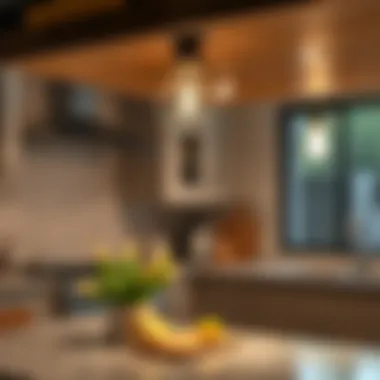
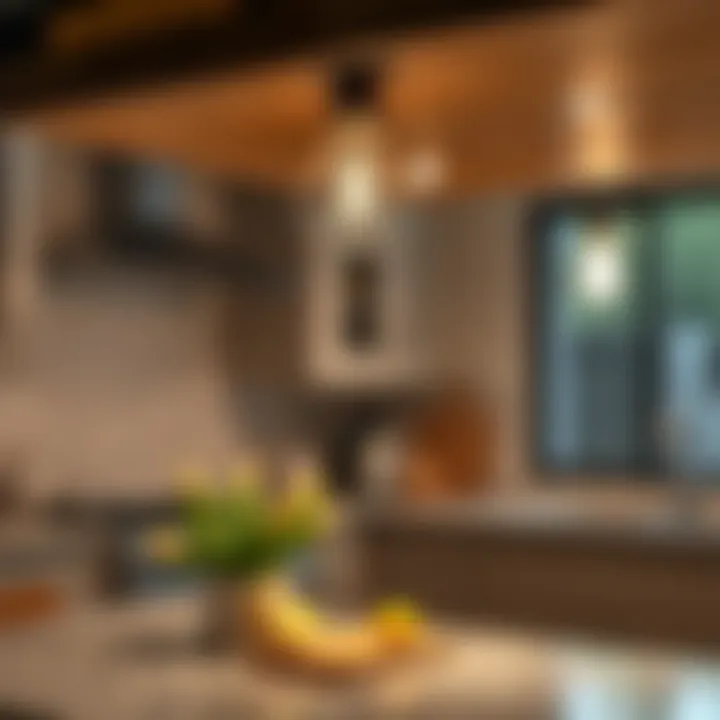
When thoughtfully integrated, the right lighting can showcase the textures of cabinetry, countertops, and backslashes, transforming even the plainest kitchens into stunning works of art. For instance, a warm hue can envelop the kitchen in a golden light, creating an inviting atmosphere, while cooler tones can evoke a crisp and modern aesthetic.
Ultimately, homeowners not only want their kitchen to be functional—they also desire a space that reflects their personality and lifestyle. Therefore, strategic lighting choices become indispensable in crafting a delightful culinary haven.
Energy Efficiency and Environmental Impact
The significance of energy efficiency in kitchen under cabinet lighting cannot be overstated. In a world increasingly concerned with environmental sustainability, every tiny detail adds to the bigger picture. Choosing the right light bulbs not only affects your electricity bills but also your carbon footprint. Understanding how various light bulb types impact energy use allows homeowners and designers to make informed decisions that align with their values and lifestyle.
Comparative Analysis of Light Bulb Types
When it comes to under cabinet lighting, several types of bulbs vie for attention. Each option carries its own implications for energy consumption and environmental impact.
- Incandescent Bulbs: Known for their warm glow, incandescent bulbs have seen a decline in popularity due to their inefficiency. They convert much of the electricity into heat rather than light, making them less favorable for energy-conscious consumers. While they provide a rich, inviting glow, they do little for the environment, averaging only about 10-17 lumens per watt.
- LED Bulbs: These have taken the spotlight in recent years, and for good reason. LEDs are exceptionally energy-efficient, producing a whopping 80-90% more light per watt than incandescent bulbs. While the initial cost may be a bit higher, their long lifespan—often 15,000 to 25,000 hours—means fewer replacements and less waste. They reduce electricity consumption significantly, which can lead to a noticeable drop in energy bills.
- Halogen Bulbs: A type of incandescent, halogen bulbs are more efficient due to their better watt-to-lumen ratio. They operate at higher temperatures and produce a bright, white light, but still carry many drawbacks associated with traditional incandescents, such as shorter lifespan and high heat output.
- Fluorescent Bulbs: Commonly found in commercial settings, fluorescent lights are now making their way into homes. They are more efficient than incandescent, and are generally cost-effective. However, their environmental impact must be considered—fluorescent bulbs contain mercury, which can pose disposal challenges.
In choosing an under-cabinet lighting solution, consider the long-term savings, environmental costs, and your specific lighting needs.
Sustainability in Kitchen Design
Sustainability in kitchen design goes beyond simply opting for energy-efficient bulbs. It embodies a holistic approach that encompasses material selection, waste reduction, and energy conservation.
- Embrace Natural Light: Incorporating ample natural lighting can reduce the need for artificial sources during the day, allowing for a more eco-friendly and refreshing kitchen environment.
- Smart Technology: Integrating smart lighting solutions can enhance energy efficiency further. For example, motion sensors can trigger lighting only when someone is present, thus reducing wasted energy.
- Recycling and Disposal: Proper disposal methods for light bulbs—especially fluorescent—are vital. Many retailers offer recycling programs that prevent hazardous materials from entering landfills.
- Long-Term Investments: Higher-quality, durable materials in both cabinetry and fixtures can minimize the need for replacements, achieving a more sustainable kitchen in the long run.
Energy efficiency and environmental conditions interweave beautifully in the tapestry of kitchen design. When done right, under cabinet lighting becomes not merely a task-focused feature, but a shining example of how modern living can harmonize with our planet's needs.
Maintaining and Replacing Light Bulbs
Maintaining and replacing light bulbs is a crucial part of ensuring your kitchen under cabinet lighting remains functional and aesthetically pleasing. It's not just about swapping out a burnt bulb; it's about maintaining the health of your lighting system, keeping your kitchen looking sharp, and ensuring safety. Over time, light bulbs can lose their brightness, color quality, and efficiency. Understanding when and how to replace them will save you from unexpected outages and potential hazards.
Identifying When to Replace
No one likes working in a dimly lit kitchen, so recognizing the signs that it’s time to replace your light bulbs is key. Here are some indicators to look out for:
- Flickering: If your light flickers or dims intermittently, it could be a sign of a failing bulb or a wiring issue.
- Color Changes: A noticeable shift in light color can signal that a bulb is nearing the end of its life. Halogen bulbs, for instance, might exhibit a warmer hue as they age.
- Reduced Brightness: If the light seems less vibrant than when first installed, it could be time for a change.
- Burnt Bulbs: This one’s pretty obvious - if a bulb is dead, it needs replacing. However, it’s wise to also check surrounding bulbs to see if they are close behind.
Replacing bulbs promptly not only keeps your kitchen illuminated but also prevents the hassle of dealing with low-light conditions during meal prep or entertaining guests.
Proper Disposal Methods
Once it’s time for a bulb swap, the next step is thinking about how to dispose of the old ones correctly. Many households don’t consider this, but light bulbs, especially certain types, require special attention when it comes to disposal. Here are the recommended disposal methods:
- Incandescent and Halogen Bulbs: These can typically go in the regular trash, but wrapping them in newspaper before discarding is a good practice to prevent injury to waste workers.
- LED Bulbs: These are generally safe to throw away in your regular household trash, but check local regulations since some areas require recycling.
- Fluorescent Bulbs: These contain mercury and must be recycled, not thrown away. Find a local recycling center that accepts hazardous waste, or look for household hazardous waste collection events in your area.
"Dispose of light bulbs properly to protect both your home and the planet."
- Use manufacturer take-back programs if available; many manufacturers have programs in place for recycling.
By being mindful of bulb replacement and disposal practices, you're not only enhancing the functionality of your kitchen but also contributing to environmental sustainability. Staying on top of these aspects fosters a kitchen atmosphere where both style and functionality shine bright.
Future Trends in Under Cabinet Lighting
As kitchens evolve into the heart of the home, under cabinet lighting is no longer merely a functional consideration; it’s become a design essential. Looking ahead, several exciting trends are transforming how homeowners, designers, and DIY enthusiasts approach this element of kitchen design. Understanding these trends not only helps in making informed choices but also ensures that the kitchen remains stylish and functional.
Smart Technology Integrations
The rise of smart home technology is making waves in various aspects of our daily lives, including kitchen lighting. Under cabinet lights are being outfitted with smart capabilities, allowing for a level of control that was unimaginable just a few years ago.
- Voice Activation: Imagine entering your kitchen and simply saying, "Turn on the under cabinet lights." Smart integrations via systems like Amazon Alexa or Google Assistant make this possible. It offers both convenience and safety, especially during late-night snacking.
- Remote Management: With smart apps, homeowners can manage their lighting from anywhere. Whether you’re coming home late or just want to impress guests with an ambiance shift, you can control your lights right from your phone.
- Automated Schedules: Setting timers or schedules can create a warm, inviting atmosphere during cooking or entertaining. Perhaps lights brighten up just before dinner time or dim down after dessert.
The benefits, of course, extend beyond convenience. These integrations often promote energy savings by allowing for precise control over when and how much light is used.
"Smart technology is not just the future; it’s the now. Under cabinet lights that can learn your habits can significantly enhance both comfort and efficiency in your kitchen."
Innovative Designs on the Horizon
Moving beyond mere function, the design aspect of under cabinet lighting is also undergoing transformation. Here, creativity meets practicality, leading to exciting innovations.
- Modular Solutions: Designers are creating modular systems that can be adjusted or expanded over time, catering to changing needs. This could mean adding more light strips as the kitchen expands or upgrading to new technology with ease.
- Architectural Lighting: No longer confined to basic fixtures, architectural lighting blends seamlessly into the design of cabinets. Think of smaller, sleek light strips tucked away so they provide light without being obtrusive—perfect for minimalist aesthetics.
- Sustainable Materials: As the world becomes more eco-conscious, designers are increasingly exploring sustainable materials for fixture placements. LED lights can be manufactured using recyclable materials, proving that luxury doesn’t have to come at the planet's expense.
Incorporating such innovative designs into kitchen lighting doesn't merely brighten the space; it enhances the overall aesthetics and functionality, creating an engaging atmosphere where cooking feels more like an art.















